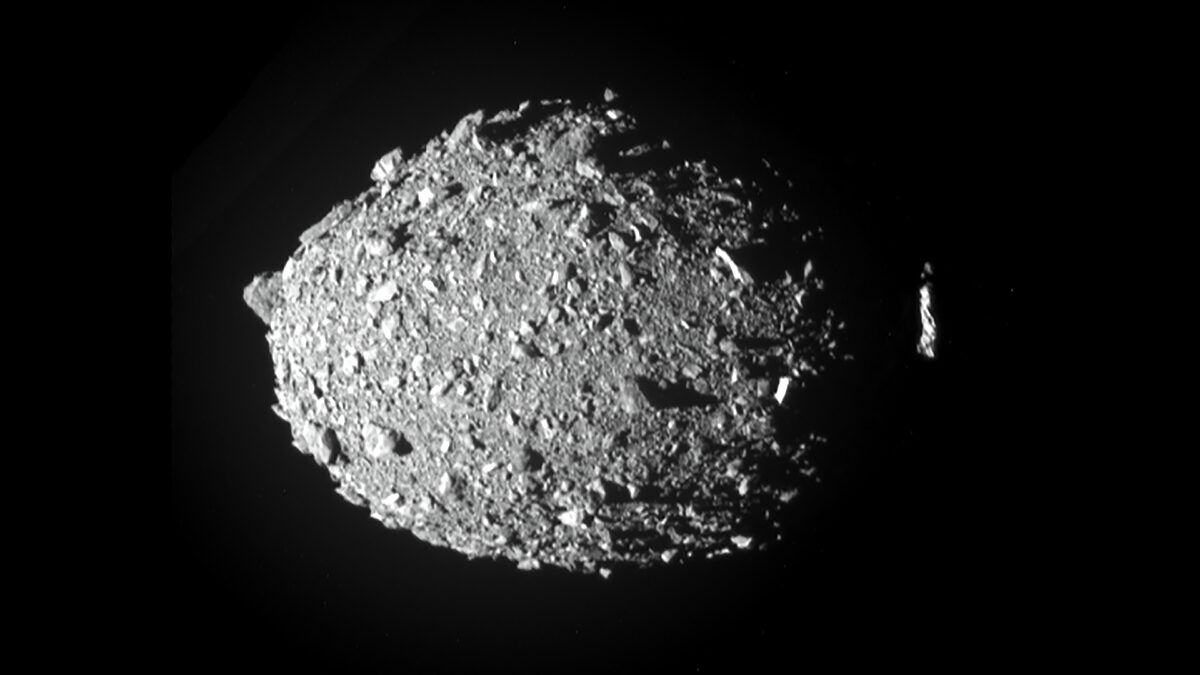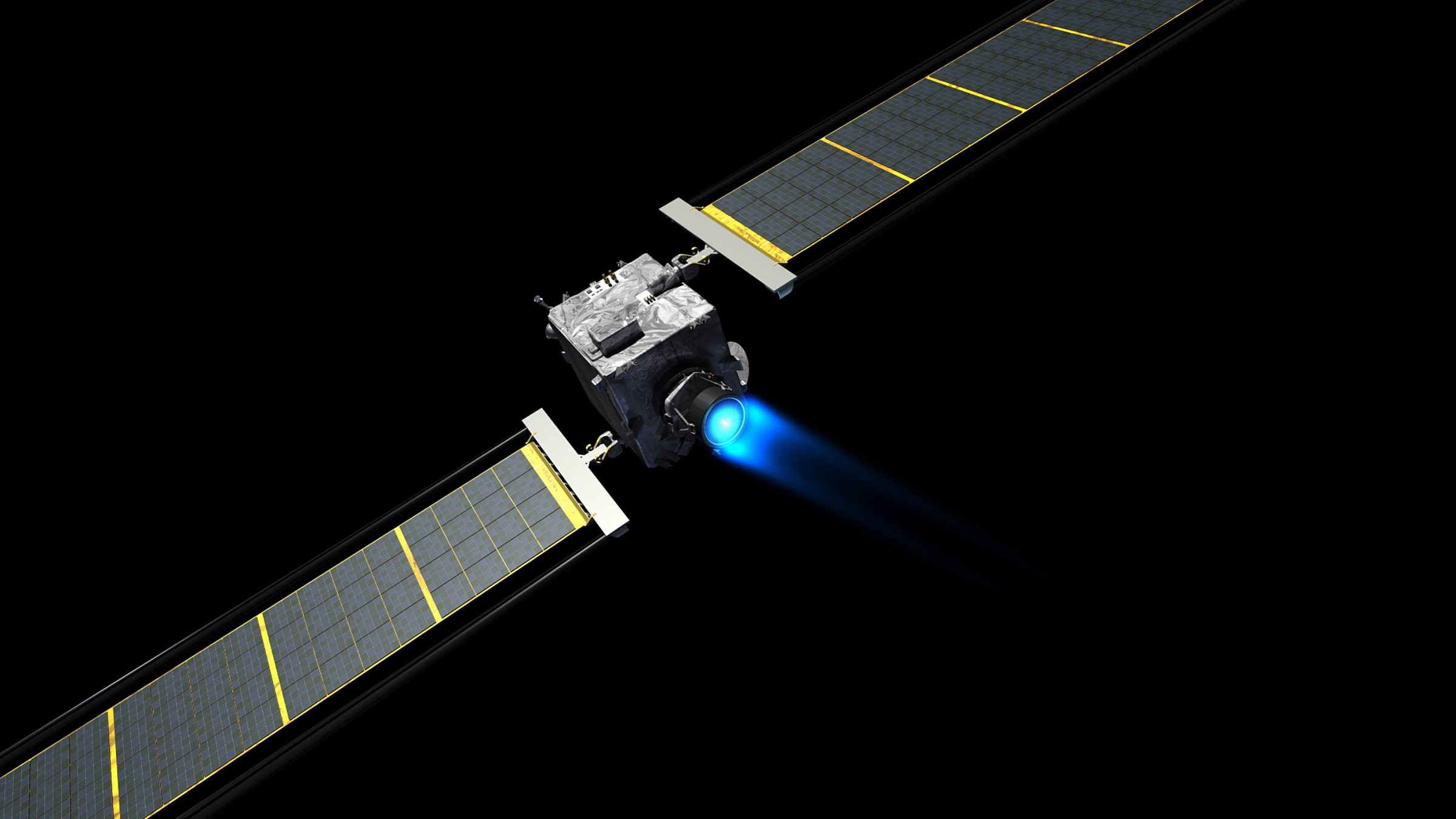DART, NASA's test to stop an asteroid from hitting Earth
Highlights
- DART was the first planetary defense mission to test a method of deflecting an asteroid on course to hit Earth.
- The threat from asteroid impacts is small but serious — and preventable. Missions like DART are essential to help us understand how to stop dangerous asteroids.
- The Planetary Society works to improve asteroid detection and reconnaissance, mature deflection technologies, and develop global response strategies.
What was DART?
What should we do if we find a dangerous asteroid on course to hit Earth? There are a number of possible deflection techniques, ranging from extreme (a nuclear blast) to benign (a heavy spacecraft using gravity to nudge the asteroid off-course).
Somewhere in between is the kinetic impactor technique. The concept is simple: slam one or more spacecraft into the asteroid at high speed to change its orbit and move Earth out of the crosshairs. This technique works particularly well if used far in advance, since small nudges can add up to big changes later on.
NASA's Double Asteroid Redirection Test (DART) was the first space mission to test this or any other asteroid deflection technique. DART launched in November 2021 and arrived at near-Earth asteroid Didymos in September 2022. On Sept. 26, the spacecraft intentionally crashed into the asteroid's small moon, Dimorphos. The crash changed the time it takes Dimorphos to orbit Didymos by 33 minutes, proving the kinetic impactor technique works.
Didymos and Dimorphos were particularly well-suited targets for DART. Although they are relatively small — Didymos measures just 780 meters (a half-mile) across and Dimorphos measures only 160 meters (525 feet) across — they pass in front of each other as seen from Earth. Optical ground-based telescopes see them as a single point of light that fluctuates in brightness as Dimorphos circles Didymos; the interval of those fluctuations should have changed after DART's impact. And while Didymos and Dimorphos are both near-Earth objects, neither comes close enough to our planet for DART to have inadvertently sent them hurtling toward us.
Two years after DART's fireworks at Dimorphos, the European Space Agency (ESA) launched a mission called Hera to study the binary asteroid system in depth. This will allow scientists to analyze DART's impact crater and understand the mission's full effect.
How much did DART cost?
The DART project cost $324.5 million. $308 million was spent on spacecraft development, $68.8 million for launch services, and $16.5 million is expected to be spent on operations and data analysis.
For additional context, read our analysis of NASA's planetary defense budget.

How did DART work?
Before it impacted Dimorphos, DART was a relatively small spacecraft. Its core consisted of a box barely a meter wide on all sides, with two roll-out solar arrays that gave the spacecraft a width of about 12 meters (40 feet). DART's electric propulsion system generated a flow of charged ions to create a gentle but continuous push.
DART launched in November 2021 aboard a SpaceX Falcon 9 rocket from Vandenberg Space Force Base in California. The spacecraft looped around Earth multiple times, using its electric thruster to gain the speed needed to escape orbit. From there it headed to Didymos, possibly flying past another asteroid named 2001 CB21 on the way.
DART's single science instrument was a high-resolution camera called DRACO that was also used for navigation. It was based on a similar camera aboard NASA's New Horizons spacecraft.
On Sept. 11, 2022, DART deployed an Italian Space Agency-built CubeSat, called LICIACube, to observe the impact. The main spacecraft was too far from Earth for flight controllers to control in real-time, so it switched to an autonomous navigation mode four hours before impact. The spacecraft’s computer relied on images from DRACO and software called SMART Nav to differentiate between Didymos and Dimorphos and steer into the latter.
And then it was over. On Sept. 26, DART crashed into Dimorphos at a speed of 6.6 kilometers (4.1 miles) per second. The collision was expected to change Dimorphos' orbital period around Didymos from 11.9 to 11.8 hours — a difference of just 4.2 minutes. But the impactor spacecraft had a much more dramatic effect on the asteroid’s motion, shortening its period by almost 10 times as much (about 33 minutes). The defense test effectively pulled Dimorphos’ orbit slightly closer to Didymos.
You can see some of DART's final images before impact here. The Hubble Space Telescope, the James Webb Space Telescope, and the LICIACube cubesat all watched as the planetary defense test mission reached its climax. Many Earth-based observatories around the globe also watched the impact.

How are DART and Hera related?
Both are part of the Asteroid Impact and Deflection Assessment (AIDA), a joint plan between NASA and ESA. NASA’s DART mission was responsible for impacting the moonlet Dimorphos, while the ESA’s Hera mission is dedicated to visiting the target asteroid post-impact and assessing how its surface and orbit changed. Though Dimorphos’ orbit is known to have been altered by about half an hour, determining exactly how the kinetic impact affected the moonlet will help refine this planetary defense method while also providing a unique opportunity for space science in general.
Who ran the DART mission?
The DART mission was a joint project between NASA and the Johns Hopkins University Applied Physics Laboratory (APL). NASA’s Planetary Defense Coordination Office funded and supervised the mission, while APL built and managed the spacecraft. The Applied Physics Laboratory also coordinates the DART teams in charge of the scientific investigation. The Italian Space Agency contributed the LICIACube cubesat to the DART mission.

Academic resources
- Rivkin, A. S., Chabot, N. L., Stickle, A. M., Thomas, C. A., Richardson, D. C., Barnouin, O., Fahnestock, E. G., Ernst, C. M., Cheng, A. F., Chesley, S., Naidu, S., Statler, T. S., Barbee, B., Agrusa, H., Moskovitz, N., Terik Daly, R., Pravec, P., Scheirich, P., Dotto, E., … Hirabayashi, M. (2021). The Double Asteroid Redirection Test (DART): Planetary defense investigations and requirements. The Planetary Science Journal, 2(5), 173.
Support missions like DART
Whether it's advocating, teaching, inspiring, or learning, you can do something for space, right now. Let's get to work.


 Explore Worlds
Explore Worlds Find Life
Find Life Defend Earth
Defend Earth


